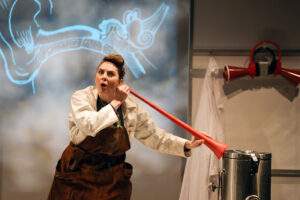BY KAY SCHROVEN
In “Babble Lab,” the Children Theatre Company’s new play running now through April 14, letters become characters and take over the Babble Lab! The Scientist whose experiment goes wrong, played by writer and actress Autumn Ness, can’t control them. They bounce, pop, fly, crawl, spring and leap. They escape from drawers and pipes and fall from the sky. They can make the Scientist happy, sad, angry, frustrated, delighted and scared. The play is inventive and thoroughly entertaining. It is aimed at preschoolers, yet enjoyable for all ages.

Autumn Ness in Children’s Theatre Company’s 2024 world premiere production of ‘Babble Lab.’ (Photo/Glen Stubbe Photography)
This is Autumn Ness’s 23rd season with CTC. And what better way to celebrate than to premiere her own play, her first, penned and produced as a one-woman show full of surprises and magic. Autumn says, “I’m nervous and excited.” She is especially excited to work with director Sarah Agnew, whom she has a great deal of respect for. “When Sarah played Alice in ‘Alice in Wonderland’ I became enthralled with her. She is a creative, generous team leader.”
Ness, our Scientist, enters the atrium where the excited children and their adults are waiting to enter the theater. She is dressed in packing foam, with headphones and a large plastic horn that amplifies all sorts of sounds; trains, traffic, jangling keys, flushing toilets, clocks ticking, bird calls and so on. Led by our zany Scientist we enter the theater amidst this cacophony of sound.
In the laboratory, cleverly designed by Michael Sommers, our Scientist in white lab coat begins her experiment handling and examining a number of random objects such as balloons, paper, chattering teeth, etc., and ends up throwing each one into a large canister which bubbles and brews and lets off steam. When the inevitable explosion happens the letters come to life and the technology blossoms throughout the theater, transporting us into a surrealistic world via projection, animation and puppetry. The letters tease, entertain and baffle our Scientist, who performs mute, much like a mime, using body language and animated facial expression to convey a multitude of ideas, thoughts and feelings.
As the play unfolds our Scientist begins to babble, that is, speak gibberish. And the children who are seated in the front rows near the stage seem to understand it perfectly. They giggle, shout and even give advice. When one of the “letters” is bothering our Scientist by squirming around on her back, a little boy shouts out “Use a back scratcher!”
Ness loves performing for this early learner audience and the interaction it creates. She says she was inspired by her own young children, as she witnessed them experiencing sound, letters, words and eventually language. Here, in “Babble Lab,” Ness has created an incubator of sound, image, light, and most importantly, the unique language of Babble. It is nonsensical and Ness speaks it fluently. This is the amazing thing about “Babble Lab” – it communicates clearly without using any known language. Ness says she was also inspired by Dadaism, an avant-garde art movement of the early 20th century, which rejected logic and reason and introduced such concepts as collage and abstract art.
If you have a youngster in your life or even if you don’t, you don’t want to miss this thoroughly upbeat production now on the Cargill Stage at the Children’s Theatre Company, 2400 Third Ave. S. in Minneapolis. Tickets are available at childrenstheatre.org or 612-874-0400.






















